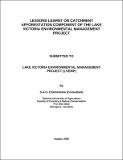| dc.description.abstract | Lake Victoria is a shared water body by the three riparian countries of Kenya, Uganda and Tanzania. The lake covers a surface area of 68 800 km2 and catchment area of 184 000 km2 and supports approximately 30 million people. The lake is important for the socio-economic well being of the surrounding communities and the national economies in terms of fish production and water for domestic, industrial and agricultural use. The lake is also of scientific interest as it habours some endemic fish species. The natural forest resources of the catchment area are also important due to a myriad of goods and services. The benefits include non-wood forest products (NWFP), timber, poles, firewood, catchment protection, soil conservation, preservation of biodiversity, carbon sequestration and moderation of climate.
Because of the indicated benefits and developmental potential of the Lake Victoria Basin (LVB), the basin has been experiencing high population growth. This coupled with poverty and weak regulatory mechanisms, has resulted into serious environmental problems with the most obvious ones being: declining of water quality, disappearance of indigenous fish species, frequent fish kills, water hyacinth infestation and algae blooms, deforestation, severe soil erosion and destruction of wetlands. The Lake Victoria Environmental Management Project (LVEMP) is a regional programme for the three East African countries and was initiated in 1997 to reverse the deterioration of the lake quality and its natural resources. The long-term development objectives of LVEMP are to: (a) Maximize the sustainable benefits to riparian countries from using resources within the basin to generate food, employment and income, safe water supply and sustain a disease free environment (b) Conserve biodiversity and genetic resources for the benefit of riparian communities and the global community (c) Harmonize national management programmes in order to achieve, to the maximum extent possible, the reversal of increasing environmental degradation. The first phase of the project was set to achieve the following: (a) To provide the necessary information, to improve management of the lake ecosystem (b) To establish mechanisms for cooperative management by the three countries and (c) To identify and demonstrate practical, self-sustaining remedies, while simultaneously build capacity for ecosystem management.
To achieve the project objectives, LVEMP is implemented in ten components. One of these components is catchment afforestation. The component was conceived to reverse land degradation in a participatory manner. The main objective of the component is to increase forest cover and arrest soil erosion through conservation. Project activities have been going on for seven years. The three East African countries are now preparing a proposal for phase two of the project and requested the services of consultants to provide analysis of components activities, interventions and approaches with a view to draw lessons learnt during the last seven years of project implementation. This report presents an analysis of the catchment afforestation component of LVEMP. | en_US |

